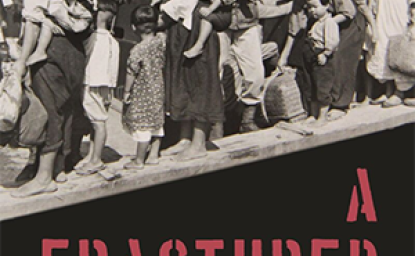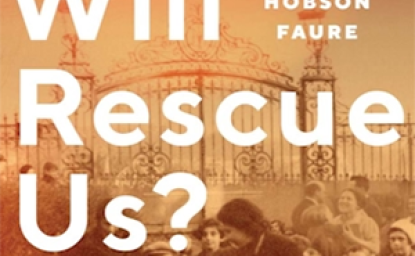BY KIMBERLY ST. JULIAN-VARNON
"Tied to Russia by no claims of blood or tradition, I still felt, while very young, an obscure attraction to this country that I only knew from its violent, highly colored folklore; its music…" -Andrea Lee on arriving in Moscow.
The late 1920s and 1930s were a time of incredible economic, social, and cultural change in the Soviet Union. The country set out on a dizzying pace of forced industrialization that led to cities born of mountains and peasants forced to starvation. On the other side of the world, a few dozen enterprising and adventurous African Americans made the decision to try their luck at economic opportunity and racial equality in the land of the Soviets. The most well-known stories of African Americans in Russia happened during this era. Often, historians examine how Black travelers benefitted from their time in the Soviet Union, but these individuals also contributed to the Soviet experiment. As African Diaspora scholar Joy Gleason Carew argued, African American visitors and workers to the Soviet Union played a role in Soviet industrialization, including introducing a strand of American cotton in Uzbekistan.
As we move away from the Stalinist period, there are fewer memoirs and travelogues from African Americans, particularly in the late Soviet era. Activist Angela Davis's 1972 visit is well-known, but her experience as a high-profile political icon was atypical. We can see a more personal and pointed account from Andrea Lee, a Black twenty-something Harvard graduate who had joined her doctoral student husband in Moscow and Leningrad during his dissertation research in 1978. Her travelogue, Russian Journal, is a fast-paced tour through Brezhnev's “stagnant” Soviet Union.
Lee's experience demonstrates the diversity of people and beliefs in late Soviet society. She and her husband Tom encountered various archetypes of Soviet people during their ten-month stay. They spent time with Grigorii, a staunch Komsomol true believer who had a penchant for Western advertisements and Donna Summer; Misha, a Soviet hippie who couch surfed his way across the Soviet Union; and Seryozha, who modeled himself after the imperial Russian intelligentsia. Her conversations and interactions with her friends and strangers highlighted the ideological tensions within Soviet society. Some friends enjoyed American films and music, but regarded American capitalism with disdain. On the other hand, Lee held an informal English class teaching Jewish students to prepare for emigration from the Soviet Union.
Moreover, Lee often experienced cognitive dissonance because of her privileged position as a foreigner. Like other Western foreigners in the USSR, she had access to the foreign stores and enjoyed freedoms Soviet citizens did not have. For example, she was shopping in a foreign store when an older Russian woman casually snuck in while the security guard was chatting. The babushka, as Lee typically refers to older Russian women, was swiftly removed—but not before getting to take in an eye-full of the store.
Some of Lee's most absorbing accounts are the vignettes of her conversations with Soviet women about the various issues they faced at home and work. During an English class, Lee and some of her students began to discuss if there was a women's movement in the Soviet Union. Rima and Raiza, two of her female students, argued that there needed to be a women's movement, because women bore the brunt of household chores, childcare, and the hours-long quest to procure groceries—all while working full-time jobs in their respective professions. In another conversation, Vera, a journalism student, talked of the hardships Soviet women endured, including her own divorce and the physical abuse her friend suffered at the hands of her husband. One of the most damning of the Soviet legacies is that violence against women and gender inequality remain significant problems in contemporary Russia.
Unlike earlier African American travelogues, which usually included comparisons between the USSR's and America's treatment of Black people, race rarely appears in Russian Journal. Lee's racial identity is only mentioned in passing, but she does note a few occasions of racial discrimination against others, including an African university student. Ibrahim, the student, was not a rarity in Moscow, as the USSR was a major destination for African and Latin American students. But Ibrahim spoke about the open hostility he and other African students faced, including being called "black devils." One of Lee’s English language students, Zhenya, regularly complained about Soviet life. In one session, he lamented that he and his wife barely made enough to support their small family despite the fact they both were engineers. During one of his usual rants, Zhenya casually explained to Lee that he and his wife called themselves a racial slur, “engin-----s,” because they likened their position to African Americans in America. (Unfortunately, Lee did not offer any other context on Zhenya’s casual use of racist language; she immediately moved on to her description of the other Zhenya in the class.) Lee also described instances in which she heard or overheard anti-Semitic remarks that make it clear to the reader the forms of everyday discrimination hurled at her students.
These episodes of racism speak to the ways in which ideology and experience diverged in the USSR. Although the Soviet Union officially proclaimed itself to be anti-racist and anti-imperialist, Jewish Soviet citizens and African residents regularly faced racism and discrimination. Thousands of Soviet Jews emigrated to Israel and the United States in the 1970s and 80s, and in 1963 African students protested the death of an African student and for better treatment by their Soviet hosts. Although traveling in different periods, African American visitors in the 1930s and Lee did not face commensurate instances of racial discrimination, because their status as foreigners from the United States superseded their race (at least in their interactions with Soviet citizens).
Lee’s travelogue is a rare glimpse beyond the ideological curtain of the late Cold War. The Brezhnev era is often portrayed as an era of stagnation. At the time, Kremlinologists painted a drab picture of a bloated state crippled by ailing leadership and stale ideology, and a worn-down, cynical citizenry. However, Lee’s point of view as an American visitor with no background in Sovietology gives us a vibrant and colorful picture of Soviet citizens and Soviet culture. Lee observed a society grappling with issues of gender equality, racial discrimination, chronic consumer good shortages, ideological disagreements, and protecting private life under the watch of the KGB. On the other hand, she also witnessed how Soviet citizens created welcoming environments for visitors, how they celebrated quaint marriage ceremonies at the Wedding Palace, how they listened and danced to the ubiquitous Boney M. records until the mandatory 11 pm curfew, and how many Soviet believers preserved their faith through participating in Easter processions in the wee hours while reciting Khristos Voskres [Christ is risen]. From her trips to the banya to a B.B. King concert in Moscow, Lee sheds light on the dynamism of the Brezhnev era and the resilience of Soviet people.
Russian Journal is also meaningful because it is a contribution to the history of African Americans in the Soviet Union and Russia. Unlike many topics in Soviet history, there are relatively few primary sources on the African American presence in the region. Historians who work on the topic during the Stalin Era have access to less than a dozen published memoirs, scattered and incomplete state archival records, and the chronicles of Black newspapers whose presses no longer print. After World War II, resources are even more scant. This historian learned of Lee’s book by chance, rummaging through footnotes looking for another citation.
There are Black stories of the Soviet Union and Russia that are waiting to be told; stories that can inform our perspectives of critical points of the history of the region, but we have to find them and preserve them first.
The opinions expressed in this article are those solely of the authors and do not reflect the views of the Kennan Institute. This article was featured as part of the Kennan Institute's Black History Month programming.






